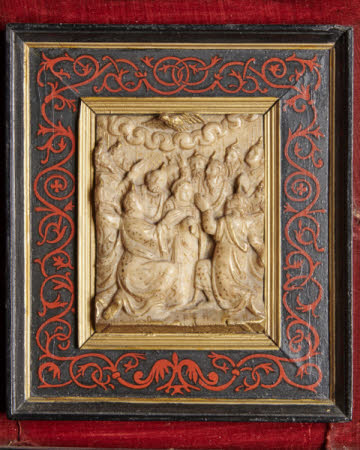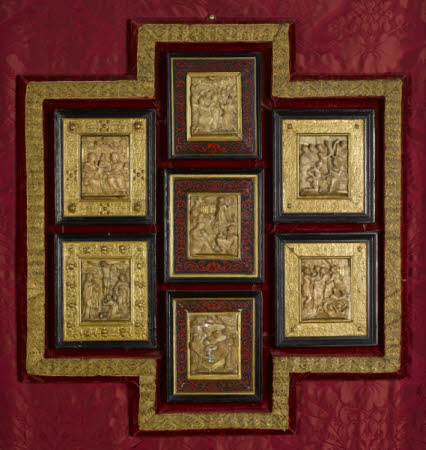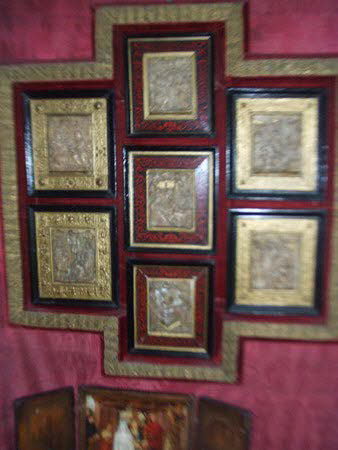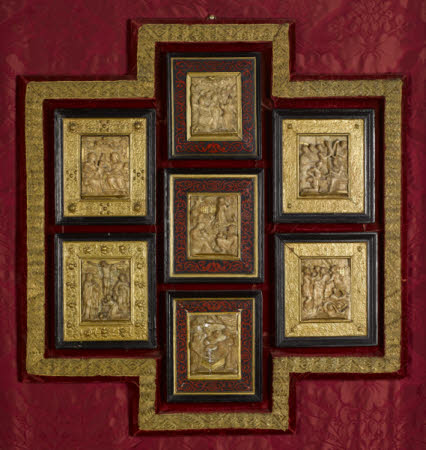Pentecost, from a series of reliefs with stories from the Life and Passion of Jesus Christ
Malines (Mechelen) Alabaster School (fl.16th-17th century)
Category
Art / Sculpture
Date
circa 1600
Materials
Alabaster, giltwood and paint.
Measurements
225 x 200 mm
Place of origin
Malines (Mechelen)
Order this imageCollection
Mount Stewart, County Down
NT 1655922.1
Summary
Sculpture, alabaster; Pentecost; Mechelen (Malines); c. 1600. A small alabaster relief from a group of seven (NT 1655922) depicting scenes from the life and Passion of Jesus Christ, made in Mechelen (Malines) in the southern Netherlands. The scene depicted here is Pentecost, when the Holy Spirit descended to Christ’s disciples, following his Crucifixion, Resurrection, and Ascension. The seven reliefs were kept with other small religious scuptures in the bedroom of Edith, Marchioness of Londonderry.
Full description
A carved alabaster panel depicting the Pentecost, in which the Holy Spirit descended to Christ’s disciples. The twelve Apostles are depicted gathered in a tight group, some standing and others kneeling, whilst the Virgin Mary kneels in their midst. The number of Apostles was made up to twelve after the departure and death of Judas Iscariot by the recruitment of Matthias. Whilst Mary prays quietly, the Apostles are full of movement, some of them gesticulating and all of them looking upwards, towards the Holy Ghost in the form of a small dove, which emerges from a ring of clouds. The Apostles have small flames emerging from their heads. The relief is unpainted but has been embellished with selective gilding: the dove, the flames emerging from the Apostle’s head, elements of the background, the dotted pattern decoration of the Apostles’ robes and the Virgin’s robes, decorated with large stars and dots. A stepped ledge at bottom. Some restoration to the gilding. Mounted in a frame, possibly original with the foliate decoration in the surround overpainted in modern times. The episode of the Descent of the Holy Ghost, known as Pentecost, took place after the Crucifixion, Resurrection, and Ascension of Christ, and is recounted in the Bible in the Acts of the Apostles (2: 1-4). After witnessing the Ascension, the Apostles returned to Jerusalem. Ten days later, on the day of the Jewish feast of Pentecost, they found themselves together in a room, when ‘suddenly there came a sound from heaven as of a rushing mighty wind, and it filled all the house where they were sitting. And there appeared unto them cloven tongues like as of fire, and it sat upon each of them. And they were all filled with the Holy Ghost, and began to speak with other tongues, as the Spirit gave them utterance.’ This passage explains the presence of the fiery ‘cloven tongues’ upon the Apostles’ heads, but also their excitement, as they are seized by the Spirit. Although the scene is not especially common in art, Pentecost is an important liturgical event, since it effectively marks the birth of the Christian church, with the Virgin Mary, not mentioned in the biblical account but usually at the centre of depictions of the scene, intended to personify the Church. The relief is one of a group of seven reliefs at Mount Stewart, probably acquired by Edith, 7th Marchioness of Londonderry and displayed in her bedroom, ‘Genoa’, arranged upon a velvet panel in the form of a cross. The 1950 inventory of Mount Stewart records just six reliefs, so it is possible that the seventh was acquired some time in the 1950s. The alabaster reliefs are part of a small collection of devotional objects kept in a corner of Genoa. In their arrangement by Lady Londonderry, the alabaster panels do not follow any liturgical order, but they all illustrate scenes from the Life and Passion of Christ: The Holy Family, with Saint Anne (NT 1655922.3) Agony in the Garden (NT 1666922.5) Betrayal of Christ (NT 1655922.4) Crowning with Thorns (NT 1655922.2) Crucifixion (NT 1655922.7) Entombment (NT 1655922.6) Pentecost (NT 1655922.1) The Mount Stewart reliefs are products of a prolific industry in alabaster carving in the southern Netherlands, that had its main centre in the city of Mechelen (Malines), and was active from c. 1550-1630. Alabaster is a form of gypsum. It has long been popular as a material for sculpture, for its relative softness and ease of carving, its attractive translucency and whiteness and its cheapness compared to marble. In England, from the twelfth through to the sixteenth centuries, alabaster carvings were produced in vast numbers by workshops based mainly in the English Midlands. The most common products of the English workshops were figurative panels, usually religious in subject matter, which formed the basis of large multi-panel altarpieces or else were used in smaller single-panel devotional altars. English alabasters were exported widely throughout Europe before the Protestant Reformation, which in England brought a sudden end to this trade. The gap in the market this created from around 1540 was quickly compensated for by the development of an important school of alabaster sculpture in the Southern Netherlands, especially in the towns of Mechelen (Malines) and Antwerp. The Mechelen alabaster workshops, which operated from around 1550 to 1630, became much more important later in the sixteenth century, as Antwerp went through severe economic crises. As well as altarpieces, these workshops specialised in making large numbers of small reliefs, often in series and generally smaller than the English alabasters, but replicating many of their subjects, albeit in a more modern late Renaissance style. The reliefs were made in enormous numbers by the artisans, who were known as ‘cleynstekers’ (carvers of small works) or ‘albastwerkers’ (alabaster workers). Sometimes the small panels were incorporated into larger altarpieces, such as the Entombment, set into the upper section of an altarpiece from c. 1550-60 in the Victoria & Albert Museum (Inv. 587-1883; Williamson 2002, pp. 150-51, cat. 50). But they were much more commonly individually framed, with the the frames incorporating decorative friezes stamped and gilded gesso. The reliefs themselves were invariably also partly gilded, so when they were freshly made they must have been spectacular in appearance, even though they were rather mass-made products, mostly modest in quality. Prints must have provided the sources for many of the images, although there is also some evidence that designs were produced in some of the Mechelen workshops. The seven Mechelen reliefs at Mount Stewart have been gathered from different sources and are certainly the products of more than one workshop. Mechelen alabasters quite often bear workshop marks which have allowed a number of these reliefs to be identified as the products of named workshops. No marks are however visible on any of the Mount Stewart reliefs. The carving of the Pentecost relief at Mount Stewart is overall quite rudimentary, the most felicitous touch the way in which the Dove of the Holy Spirit overlaps the frame, so seems to burst into the viewer’s space. No print source for the design has been identified. Other Mechelen reliefs depicting Pentecost include: Musées Royaux des Beaux-Arts, Brussels (Derveaux-van Ussel 1967a, no. M.20); Musée d’art religieux et d’art mosan, Liège (Bès de Berc 2003, p. 162) ; Niedzica Castle Museum (Kriegseisen and Lipinska 2011, no. I.47; Stadsverzameling, Tongres (Bès de Berc 2003, p. 162) ; Städtisches Museum in Trier (Derveaux-van Ussel 1967, nos. 84-85; Derveaux-van Ussel 1967a, nos. M/52, M/67, fig. 28; Bès de Berc 2003, p. 163). Jeremy Warren August 2022
Provenance
Probably acquired by Edith, Marchioness of Londonderry (1878-1959); by descent to Lady Mairi Bury (1921-2009); accepted by HM Government in lieu of Inheritance Tax and allocated to the National Trust, 2013.
Makers and roles
Malines (Mechelen) Alabaster School (fl.16th-17th century), sculptor
References
Mount Stewart 1950: Inventory and Valuation of the Contents of Mount Stewart, Newtownards, County Down, the property of the Marchioness Dowager of Londonderry, D.B.E. Prepared for the purpose of insurance by H. Clifford-Smith, M.A. F.S.A. 1950, p. 43. Jansen 1964: Ad Jansen, ‘Mechelse Albasten‘, Handelingen van de Koninklijke Kring voor Oudheidkunde, Letteren en Kunst van Mechelen, 68 (1964), pp. 111-191. Derveaux-van Ussel 1967: Ghislaine Derveaux-van Ussel, ed., Mechelner Alabaster, exh. cat., Städtsiches Museum, Trier 1967 Derveaux-van Ussel 1967a: Ghislaine Derveaux-van Ussel, Exposition de Sculptures anglaises et malinoises d’Albâtre, exh. cat., Musées Royaux des Beaux-Arts, Brussels 1967. Williamson 2002 : Paul Williamson, Netherlandish Sculpture 1450-1550. London 2002 Bès de Berc 2003: Guy Bès de Berc, Sculptures d’albâtre de Malines. Les reliefs de dévotion, fin XVIème début XVIIème siècle, Saint Armel 2003. Kriegseisen and Lipinska 2011 : Jacek Kriegseisen and Aleksandra Lipińska, Materia światła i ciała/Matter of light and flesh. Alabaster in the Netherlandish sculpture of the 16th and 17th centuries, exh. cat. National Museum in Gdańsk, Gdańsk 2011 Lipinska 2015 : Aleksandra Lipińska, Moving Sculptures. Southern Netherlandish Alabasters from the 16th to 17th centuries in Central and Northern Europe, Leiden 2015.




